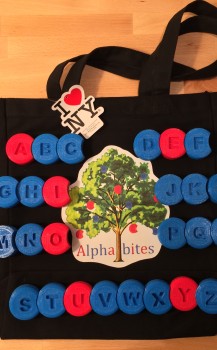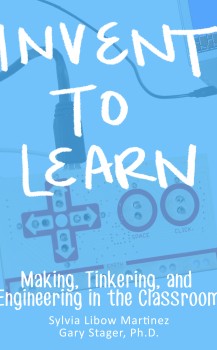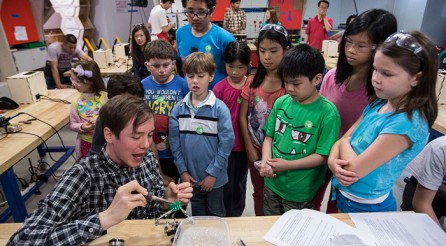Following the announcement of our new strategic plan last January, students, faculty and families have been VERY excited about the makerspace we will soon be building for our primary and secondary schools. Those familiar with the concept of “making”, often because they have visited the “makerfaire” that takes place at the New York Hall of Science (NYHOS) each fall, are thrilled to know that the LFNY will be providing a place for creativity that is deliberately tailored to the challenges and opportunities of the 21st century.
For those discovering the makerspace, some explanation is needed, but they quickly see how essential it will be to advancing our educational priorities for the next five years, particularly that of ensuring that all of our students, and not just those who end up choosing the “S” track of the French Baccalaureate, are prepared for the science-, technology-, engineering-, arts- and math-intensive world which defines our times.
Please find below replies to a few of the questions which members of our community have asked, including some especially inspiring words from a remarkable twelfth grade student at the Lycée Français de New York, Ben K. In addition to excelling at our school, Ben happens, to the delight, I am sure, of countless young inventers around the city, to work part-time at the NYHOS.
These “alphabites” were created using the LFNY’s 3D printer, which is currently located in the Primary library, but will ultimately be moved to our makerspace. This alphabetical puzzle was completed by 9th grader Léo D. and Primary ESL teacher Gretchen Schell to serve the needs of an English teacher in our partner school in Haiti, the Lycée Jean Baptiste Pointe du Sable. (credit: Young Kim)
What is a makerspace?
One of the most simple definitions comes from the Maker Education Initiative, a non-profit organization founded in 2012 by Dale Dougherty. Dougherty established the foundations of what has become known in the United States and elsewhere as the “maker movement:” Make Magazine, launched in 2005; and the “world’s largest do-it-yourself festival” otherwise known as the MakerFaire, initiated in the San Francisco Bay Area in 2006 (see below Dougherty’s TED talk “We are Makers,” delivered in 2011).
A makerspace, according to Makered’s Makerspace Playbook, is a place “where…new and experienced makers”, understood as people who imagine something and then transform that something into a concrete object, “work on real and personally meaningful projects, informed by helpful mentors and expertise, using new technologies and traditional tools.” NB. These technologies and tools vary from one such place to another, but typically range from sewing machines to soldering irons to woodwork lathes to graphic design software to 3-D printers to laser cutters.
Yet enticing as it is, this list is not what matters most. As our Terminale student Ben K. explains, “A makerspace is a place where people have the space, resources, and environment to make what they want. The tools are second to having a space where people can make, and where people can talk about making. While we are in NYC, and garages and backyards are few, I think a space to make stuff, and space to store projects when not making, are among the most important parts of a makerspace.”
What is the educational philosophy behind a makerspace?
On both sides of the Atlantic, whether it be Jean Piaget in Switzerland or John Dewey in the United States, educational philosophers have long appreciated the exceptional value of learning by doing. For Piaget, “to understand is to invent”, i.e. the deepest understanding is often that which a person is able to build himself or herself, no puns intended. Or as Dewey affirmed in Democracy and Education, the path-breaking book he published in 1916, “give the pupils something to do, not something to learn, and if the doing is of such a nature as to demand thinking; leaning naturally results.”
Perhaps the most compelling arguments in favor of “making” come from one of the great figures of integrated science-technology-engineering-art-and-mathematics education, MIT Professor Seymour Papert, whose research and practice have demonstrated the extraordinary power of not just equipping students with a creative mindset, but also taking “a step further towards action.” For Papert, “Although the learning happens inside the learner’s head, this happens most reliably when the learner is engaged in a personally meaningful activity outside of their head. This shareable construction may take the form of a robot, musical composition, papier maché volcano…” (Sylvia Libow Martinez and Gary Stager, Invent to Learn: Making, Tinkering and Engineering in the Classroom). What a makerspace allows is precisely this extension of creative thinking into creative doing.
Why is a makerspace so important to 21st century education?
While learning through doing has always been important, this pedagogy is especially relevant for the world of today and tomorrow. The memorization of knowledge is no substitute for the curiosity, problem-solving, inventiveness, experimentation and perseverance which together constitute what Harvard Professor Tony Wagner describes as the most vital competency for our emerging century: innovation. David Wells, who oversees making and learning at the New York Hall of Science, contends: a makerspace teaches “kids how to break down their big ideas into smaller components in order to figure out a plausible first step”, to “become familiar not just with makerspace tools but, more important, with the process of finding, accessing and using information to teach themselves how to do whatever it is they want to do, and make whatever they want to make…We’re developing the ‘I can’ mentality.”
The Makerspace at the New York Hall of Science. (Credits: NYSCI)
Moreover, as our student Ben has shared with me, makerspaces empower self-motivated creativity: “A makerspace would allow students to follow interest-based learning, where it’s their interest to build something that leads to them learning. When I wanted to create a system which lights up lights based on what frequency of music is playing, it led me to learn essentially everything in the program about electricity, and much beyond that, in order to create the circuit.”
If you would like to learn more and contribute your own thoughts about the makerspace we are designing for 2016-17, please do not hesitate to contact me. Keep your eyes peeled too for additional blogging on this topic in the coming weeks, as well as a special meeting this fall dedicated to making. For Ben K. , “I don’t dream of making any one thing. I dream of making what I want. And this is only what I dream of creating for myself. If I look at what can be made to benefit others, the possibilities are endless.” Dear members of the LFNY community, we owe it to our students to support this vision.
NB. The heading of this post is the French translation of the title of the outstanding book by Sylvia Libow Martinez and Gary Stager, “Invent to Learn: Making, Tinkering and Engineering in the Classroom” (Torrance, California: Constructing Modern Knowledge Press, 2013)
About the Author :
Sean Lynch was Head of School at the Lycée Français de New York from 2011 to 2018, after having spent 15 years at another French bilingual school outside of Paris: the Lycée International de St. Germain-en-Laye. Holding both French and American nationalities, educated in France (Sciences Po Paris) and the United States (Yale), and as the proud husband of a French-American spouse and father of two French-American daughters, Sean Lynch has spent his entire professional and personal life at the junction between the languages, cultures and educational systems of France and the United States. In addition to being passionate about education, he loves everything related to the mountains, particularly the Parc National du Mercantour.




